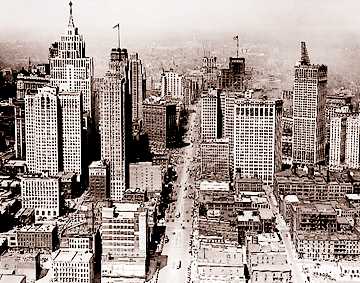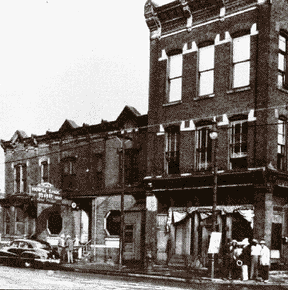
(Detroit Skyline, 1929.)
Writing about Detroit means writing about The Line. Manufacturing stuff was what provided the economic base that produced the graceful boulevards and avenues that made the city once called- without irony- “The Paris of the Midwest.”
Detroit ranked third in the nation, after New York and Chicago, in the number of major buildings erected during the Roaring Twenties. The boom proved dramatic and lasting.
In 1919, General Motors began construction of its new headquarters, the largest office building in the world at the time, followed by the First National Bank Building in 1922.
The Penobscot Building, begun in 1928, was the tallest in the city for nearly 50 years, until the RenCen went up. The Book brothers transformed Washington Boulevard into a replica of New York’s Fifth Avenue. The Book Cadillac Hotel at Michigan and Washington was the jewel of the city hotels. In 1928, the beaux-arts Fisher Building, across the street from the General Motors Building, provided a commercial anchor.
Of course it was the factories that made the Motor City one of the major termini of the Great Migration from the south. Whites from Appalachia and the upper south came during the Roaring Twenties and settled in places like the Cass Corridor.
African Americans came to the Black Bottom and Paradise Valley nieghborhoods of the Near East Side. That was a bounded by Gratiot Avenue, Brush Street, Vernor Highway, and the tracks of the Grand Trunk and Western Railway. The main commercial strips were Hastings and St. Antoine streets, which Coleman Young knew well as a young man since his father operated a small dry-cleaning shop and worked a second job as a night watchman.
That was the way things worked if you were going to take care of a family, and did not live in one of the grand houses in The Indian Village, or work in one of the proud towers that were thrust up in the Roaring Twenties. Working shifts was what Detroit was all about when the factories roared around the clock, and when they did not, times were tough. The Depression hit Black Bottom hard. Strict covenants and the practice of Red Lining contained the black population there, and the area began to fray at the seams and even the recovery of the war years only made the pressure for decent housing worse.

(The 606 Horse Shoe Bar in Black Bottom.)
By the time Raven and Magpie were able to move into the city from Ferndale in 1954, Black Bottom had a vibrant community of black-owned business, social institutions and night clubs. By day, the center of black Detroit was exactly that. But by night, the neon lights, jazz and blues drew white crowds. Duke Ellington, Billy Eckstien and Count Basie were regulars, and Ella Fitzgerald were regulars.
Aretha Franklin’s father, Rev. C.L. Franklin, opened his New Bethel Baptist Church in the heart of Black bottom.
Night-life aside, pressure on the housing market caused middle-class Black to move north and west from the neighborhood. The real estate shenanigans that went along with block busting chased my folks out of town and up Woodward to Grabbingham. They were only renting in the Motor City, not trapped with a mortgage like Clint Eastwood in “Gran Torino,” the movie filmed right there.
Black Bottom became a seriously blighted neighborhood. Grand visions of a renewed Detroit destroyed virtually every vestige of Paradise Valley and Black Bottom as Interstate 75 plowed through the area in the 1960s.
I mention that because of what my pal Muhammed recalled the other day. He got out of town in 1973 while the getting was good. He remembered driving around in the Vega Kammback on a few occasions, before he left for Arizona.
He remembered something I didn’t. “One night we piled into the Vega for a very speedy drive home from a night Tigers’ game. I think on the way to the game you were still observing a 55 speed limit till the car hit a certain number of miles and was broken in. I think you blew off that limit and drove 85 the whole way home. I remember the Vega as one of the first “tin can’ type small cars I had ridden in other than a VW bug.”
Oh, man, I had not thought about the old ball park in a while, nor the time on The Line that we all spent building those pieces of crap.
Tiger Stadium is gone now, too. Along with all the jobs on the Line. And the reason I mentioned Black Bottom was that we passed the Jeffries Projects that night on I-75, rocketing through what had been a neighborhood and now is just crumbling concrete and asphalt.
We were all UAW workers, too. Went with the territory. I will have to get to The Line and Solidarity Forever tomorrow, I guess.

Copyright 2011 Vic Socotra
www.vicsocotra.com
